Michael J. Behe's Blog, page 505
March 25, 2019
Researchers: Newly discovered frog separated from others by 50 million years
 The starry dwarf frog camouflages very well./ K.P. Dinesh
The starry dwarf frog camouflages very well./ K.P. Dinesh The thumbnail-sized species was discovered in India’s Western Ghats, one of the world’s “hottest” biodiversity hotspots. Scientists have named the frog Astrobatrachus kurichiyana for its constellation-like markings and the indigenous people of Kurichiyarmala, the hill range where it was found.
But A. kurichiyana is not only a new species to science. It’s the sole member of an ancient lineage, a long branch on the frog tree of life that researchers have classified as a new subfamily, Astrobatrachinae.
“This is an oddball frog—it has no close sister species for maybe tens of millions of years,” said David Blackburn, the associate curator of herpetology at the Florida Museum of Natural History. “With frogs, there are still ancient lineages out there awaiting discovery. This gives us one more puzzle piece to think about deep time.” Natalie Van Hoose, “Meet India’s starry dwarf frog, lone member of newly discovered ancient lineage” at Phys.org
The researchers were pretty surprised:
“I had no clue I was holding onto a 50-million-year-old lineage,” Vijayakumar says. The researchers say the frog represents not just a new species and genus, but possibly even a new family, which they are working to confirm through genetic analysis and anatomical comparisons. “It’s a unique, old lineage without any close relatives” known to science, he says. Jeremy Rehm, “Meet India’s starry dwarf frog — a species with no close relatives” at ScienceNews
At one point, one of them seems to forget thepoint of the story:
Scientists have found many ancient lineages of frogs in the Western Ghats, whose biodiversity stems from its history and distinct geography. India, once part of Africa, split from Madagascar about 89 million years ago and drifted northeast, eventually colliding with the Asian mainland and giving rise to the Himalayas. But its long isolation as an island provided fertile ground for the evolution of new life forms and may have sheltered species that disappeared elsewhere. This is especially true of the Western Ghats, which is much like a network of islands, Vijayakumar said. The elevated region has been cross-sectioned into separate hill ranges by millions of years of erosion and climatic changes.
“It’s a perfect scenario for cooking up new species,” he said. Natalie Van Hoose, “Meet India’s starry dwarf frog, lone member of newly discovered ancient lineage” at Phys.org
What? Wait! This isn’t a “new species.” This is a holdover from 50 million years ago, during which time it has always been an obvious frog. If we wanted to demonstrate “cooking up new species,” we’d best not make this frog Exhibit A.
Won’t more genome mapping turn up more of these oddities? It’s one thing if very unusual things happen now and then. But if they are happening a lot, our model may need some revisions or it’s going to be biology’s version of Ptolemy’s astronomy plodding through the 21st century. That is, you can sort of make it work, but…
But what is a “species” anyway?
Follow UD News at Twitter!
See also: A physicist looks at biology’s problem of “speciation” in humans
and
Stasis: Life goes on but evolution does not happen
Copyright © 2019 Uncommon Descent . This Feed is for personal non-commercial use only. If you are not reading this material in your news aggregator, the site you are looking at is guilty of copyright infringement UNLESS EXPLICIT PERMISSION OTHERWISE HAS BEEN GIVEN. Please contact legal@uncommondescent.com so we can take legal action immediately.
Plugin by Taragana
Motor nerves turn out to need “expert guidance”

Left: Motor neurons (green) exit the spinal cord (red) and enter the periphery of the body to connect with muscles. Right: Motor neurons (white arrow) without the guidance of p190 are trapped within the spinal cord./Salk Institute
To find their way to their destinations in the body:
LA JOLLA—(March 22, 2019) Similar to the dozens of Sherpas that guide hikers up treacherous Himalayan mountains to reach a summit, the nervous system relies on elaborate timing and location of guidance cues for neuronal axons—threadlike projections—to successfully reach their destinations in the body. Now, Salk Institute researchers discover how neurons navigate a tricky cellular environment by listening for directions, while simultaneously filtering out inappropriate instructions to avoid getting lost. The findings appeared in Neuron on March 19, 2019.
“There are 100 trillion connections in the nervous system governed by 20,000 genes, of which roughly 10 gene families are known to be involved in controlling axon guidance. We wanted to understand the clever genetic systems nature has employed to wire the most complicated biological machine in the universe,” says Salk Professor Samuel Pfaff, senior author and a Howard Hughes Medical Institute investigator. “Thus, we set out to examine how motor neurons find their connections with muscles in the body, which is critical for our brain to relay information to our muscles to allow for movement.” “Like mountaineers, nerves need expert guidance to find their way
” at Salk News
Paper. (paywall)
And it all happens without intelligence of any kind? “Expert guidance” without experts?
Realizing that people are compelled to believe that helps us understand at least one thing: Why are theories like consciousness is an evolved illusion or a material thing—or otherwise, you and your coffee mug are both conscious—taken seriously? To the point where it is a credible observation that consciousness is a bizarre field of science?
That’s because people who insist on believing that there is no design in nature, that it all happens due to natural selection acting on random mutations (Darwinism), must believe whatever nonsense supports that. And if everyone is a fool, who’ll notice?
Follow UD News at Twitter!
Before you go: Cells find optimal solutions. Not just good ones.
Researchers build “public library” to help understand photosynthesis
Wait. “The part of the plant responsible for photosynthesis is like a complex machine made up of many parts, … ” And machines just happen all by themselves, right? There is no information load to account for; it just evolved by natural selection acting on random mutation the way your Android did!
In Nature: Cells have “secret conversations” We say this a lot: That’s a lot of information to have simply come into being by natural selection acting on random mutation (Darwinism). It’s getting not only ridiculous but obviously ridiculous.
Researchers: Helpful gut microbes send messages to their hosts If the strategy is clearly identified, they should look for non-helpful microbes that have found a way to copy it (horizontal gene transfer?)
Cells and proteins use sugars to talk to one another Cells are like Neanderthal man. They get smarter every time we run into them. And just think, it all just tumbled into existence by natural selection acting on random mutations (Darwinism) too…
Researchers: First animal cell was not simple; it could “transdifferentiate” From the paper: “… these analyses offer no support for the homology of sponge choanocytes and choanoflagellates, nor for the view that the first multicellular animals were simple balls of cells with limited capacity to differentiate.”
“Interspecies communication” strategy between gut bacteria and mammalian hosts’ genes described
Researchers: Cells Have A Repair Crew That Fixes Local Leaks
Researchers: How The Immune System “Thinks”
Follow UD News at Twitter!
Researcher: Mathematics Sheds Light On “Unfathomably Complex” Cellular Thinking
How do cells in the body know where they are supposed to be?
Researchers A Kill Cancer Code Is Embedded in Every Cell
Copyright © 2019 Uncommon Descent . This Feed is for personal non-commercial use only. If you are not reading this material in your news aggregator, the site you are looking at is guilty of copyright infringement UNLESS EXPLICIT PERMISSION OTHERWISE HAS BEEN GIVEN. Please contact legal@uncommondescent.com so we can take legal action immediately.
Plugin by Taragana
A philosopher explains why machines are not creative

Creativity, says Sean Dorrance Kelly, does not follow computational rules:
He worries about something quite different from the usual robots-are-coming concern, “It is entirely possible that we will come to treat artificially intelligent machines as so vastly superior to us that we will naturally attribute creativity to them. Should that happen, it will not be because machines have outstripped us. It will be because we will have denigrated ourselves.” “More at Mind Matters
When you consider all the reasons why machines cannot be creative, one must ask, is the belief that we can build superintelligent machines rooted in naturalism (nature is all there is), often called “materialism,” or in evidence?
See also: Artificial intelligence must be possible. Really? (Eric Holloway)
Why I doubt that AI can match the human mind (Jonathan Bartlett)
The superintelligent AI myth (Brendan Dixon)
AI just needs a bigger truck! (Robert Marks)
Software pioneer says general superhuman intelligence is very unlikely
and
Machines cannot take over
Copyright © 2019 Uncommon Descent . This Feed is for personal non-commercial use only. If you are not reading this material in your news aggregator, the site you are looking at is guilty of copyright infringement UNLESS EXPLICIT PERMISSION OTHERWISE HAS BEEN GIVEN. Please contact legal@uncommondescent.com so we can take legal action immediately.
Plugin by Taragana
Logic and First Principles, 15: On the architecture of being. Or, are certain abstract entities (“abstracta”) such as numbers, natures, truth etc real? If so, how — and where?
For some weeks now, an underlying persistent debate on the reality of numbers has emerged in several discussion threads at UD. In part, it has been cast in terms of nominalism vs platonic realism; the latter being the effective view of most working mathematicians. Obviously, this is a first principles issue and is worth focussed discussion.
Now, No. 14 in this series, on objectivity of aesthetics principles as canons of beauty, begins by pointing to an underlying challenge:
We live in a Kant-haunted age, where the “ugly gulch” between our inner world of appearances and judgements and the world of things in themselves is often seen as unbridgeable. Of course, there are many other streams of thought that lead to widespread relativism and subjectivism, but the ugly gulch concept is in some ways emblematic. Such trends influence many commonly encountered views, most notably our tendency to hold that being a matter of taste, beauty lies solely in the eye of the beholder.
Of course, F H Bradley, long since pointed out that to claim the un-know-ability of things in themselves is already to claim a major point of just such knowledge. So, this is self-referentially absurd. Wisdom, then, is to acknowledge that we can and do err but even that is a point of undeniably certain knowledge therefore we can and do confidently know some aspects of reality as it is, not just as it appears to us. Reality is in part intelligible, it is not utterly inscrutable. Already, this is a hint that there is a rational . . . a logical . . . structure to being which rational creatures may seek to understand, succeeding part of the time. Where of course aspects of that structure will be quantitative.
Let me highlight the core argument (and pardon the inflexibility of the new block style WP is using):
>>to assert that in effect conceptualism about abstracta is true, one relies on abstracta being in reality, e.g. here that a description or assertion can hold a relationship of accurate description with things as they are. Absent the reality of such a relationship independent of our individual or collective concepts, truth is meaningless. If only the concrete exists in reality, truth, an abstract relationship using symbolic representation (other abstracta!) is a case of non-being, illusion. Actually, illusion is another abstract relationship. Meaninglessness is next up, but this too is an abstract state of affairs. The infinite regress of abstracta begging to be acknowledged as real yawns open.
The reality of core abstracta is inescapably the case, i.e. it is
necessarily true on pain of not being able to think, communicate
conceptually, reason [implication is abstract], speak truth,
demonstrate, warrant, know etc.
The serious issue then follows: in what way are such things real?
The best I can answer for now is that such abstracta are connected to
the logic of being for worlds or things in the world. They are
logically relevant characteristics of being, which in many cases are
shared across beings as archetypes that are in-common, or even are
in-common across possible worlds. In some cases such as numbers they are
in common to all possible worlds as part of the fabric of any distinct
possible world.
We may recognise or discover them and try to identify what they
precisely are, but in many cases they defy particular definition in
words.
Where do they come from, where are they? They come from the logic of
being and are embedded as constraints on being. For instance, no entity E
is such that it has two core characteristics x and y where y = ~x.
That is why square circles are impossible of being. Regardless of how we may form a fuzzy imagination that oscillates between the shapes or may try to superpose and blend the two.
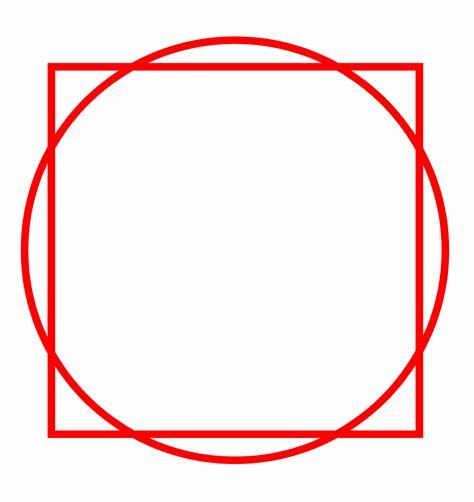 There are squares, there are circles but no square circles
There are squares, there are circles but no square circlesThus, abstracta are part of the distinct identity, nature and being of any particular entity.
That is, the principle of distinct identity has ontological, not just
conceptual, significance. That’s why we recognise it as a first
principle of right reason.
So, not a spooky, mysterious, metaphysical world of forms, just the architecture of — rational principles or “logic” of — being or possible being (and of impossibility of being). Where of course a considerable part of that embedded architecture of being is structural and quantitative. That is, Mathematical. Mathematics has in key part ontological import. Hence, Wigner’s point on its astonishing power. The music of the spheres is written in the language of mathematics, with — I daresay — Fourier leading the charge.>>
Fourier in action:
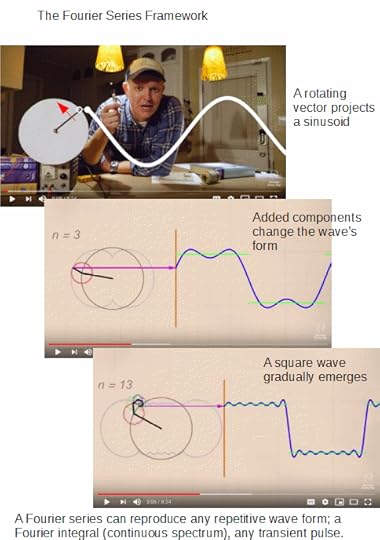
And again (a mechanical implementation in our hearing . . . relevant to octaves and fifths in music etc):
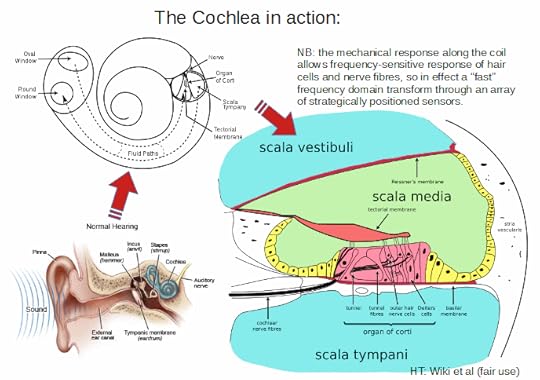
Let me then set it in the context of an ongoing exchange in the thread on beauty, and I take liberty to headline comment 390:
KF, 390: >>H, Let’s roll the tape a bit:
H, 377: >>kf writes,
What happens in the world is independent of [–> antecedent to and insofar as it is intelligible, influences] our thoughts about it [which thoughts in many cases may and do accurately describe reality, concrete and abstract.”
I’ll agree that the world is antecedent to our thoughts: we experience the world and then form thoughts about.
I’ll agree that “insofar as it is intelligible, [the world] influences our thoughts about it, which thoughts in many cases may and do accurately describe reality, concrete and abstract” [sorry, WP suppressed strike-throughs]>>KF, 378: >>H, that apparent rejection of the reality of certain abstracta, if so, is fatally self-referential for much the same reason as nominalism (which is a form of such rejection) fails.>>
H, 379: >>I’ve explained my position, and see nothing “fatally self-referential” in it. The world is intelligible, and we are intelligent, so our understandings provide reasonably accurate maps of the world. We use abstractions to describe the world, but the world itself is “concrete” in the sense that it is its behavior which we observe that is the source of the material for our abstractions.
Probably no need for you (or me) to repeat ourselves again (although I do have a new thought on the matter that I may share later in the day when I have some time.)>>KF, 380: >>when an objective matter is on the table, agreement or disagreement is immaterial. Just to make statements you have had to repeatedly rely on abstracta being the case not just perceptions. Indeed, truth is an abstract relationship of statements to what is the case, belief or disbelief, agreement or disagreement too. The reality of core abstracta is inescapable.>>
H, 381: >> I have clearly said that we use abstractions – we have to – just to talk about the world, so of course I agree with you when you write, “Just to make statements you have had to repeatedly rely on abstracta being the case not just perceptions.” Perceptions of the world bring in the data from which we create our abstractions, but abstractions are a necessary, central aspect of our ability, as rational, logical creatures, to understand the world.
Is this the point upon which you think my position is “fatally self-referential”?, because if so it misrepresents me. Perhaps you could explain more about your “fatally self-referential” statement.>>KF, 382: >>this begins to approach the inescapability of the laws of thought, which embed cases in point. To attempt to deny one is forced to accept implicitly. For instance, you are affirming or implying that somethings are true, are accurate descriptions of reality, which is itself an abstract relationship, indeed the words and what they represent involve abstract relations. That is telling us something — we are at a start-point.>>
H, 383: >>Yes, I have continually said that we use abstract concepts to make statement about reality that are, to various degrees, accurate descriptions.>>
KF, 386: >>we cannot escape core abstracta and they are inescapably true or real as appropriate.>>
H, 389: >>kf writes “that apparent rejection of the reality of certain abstracta, if so, is fatally self-referential.” I accept the reality of the abstract concepts we create that describe the reality we experience. How is that “fatally self-referential”? I don’t see how you have explained that.>>
Notice, how you repeatedly affirm certain things to be true, i.e. to actually accurately describe real states of affairs? That is itself an abstract relationship, which must be real albeit abstract or discussion collapses. Likewise, the Mobius strip’s behaviour pivots on how it has ONE edge, ONE surface, etc. So if by cutting we introduce one or two further edges, it will form a longer loop or two interlocked loops. One-ness, two-ness, three-ness and consequences on the logic of being are abstract but take effect in space and bodies. It does so independent of our thoughts, concepts, expectations, as the relevant abstract properties are part of its core characteristics.
Above, at 375, I again laid out a demonstration as to why numbers are necessary entities that will manifest in any possible world, antecedent to our thoughts about a world. We are contingent beings within an already formed world.
Going back to the self-reference, to assert that in effect conceptualism about abstracta is true, one relies on abstracta being in reality, e.g. here that a description or assertion can hold a relationship of accurate description with things as they are. Absent the reality of such a relationship independent of our individual or collective concepts, truth is meaningless. If only the concrete exists in reality, truth, an abstract relationship using symbolic representation (other abstracta!) is a case of non-being, illusion. Actually, illusion is another abstract relationship. Meaninglessness is next up, but this too is an abstract state of affairs. The infinite regress of abstracta begging to be acknowledged as real yawns open.
The reality of core abstracta is inescapably the case, i.e. it is necessarily true on pain of not being able to think, communicate conceptually, reason [implication is abstract], speak truth, demonstrate, warrant, know etc.
The serious issue then follows: in what way are such things real?
The best I can answer for now is that such abstracta are connected to the logic of being for worlds or things in the world. They are logically relevant characteristics of being, which in many cases are shared across beings as archetypes that are in-common, or even are in-common across possible worlds. In some cases such as numbers they are in common to all possible worlds as part of the fabric of any distinct possible world.
We may recognise or discover them and try to identify what they precisely are, but in many cases they defy particular definition in words.
Where do they come from, where are they? They come from the logic of being and are embedded as constraints on being. For instance, no entity E is such that it has two core characteristics x and y where y = ~x.
That is why square circles are impossible of being. Regardless of how we may form a fuzzy imagination that oscillates between the shapes or may try to superpose and blend the two.Thus, abstracta are part of the distinct identity, nature and being of any particular entity. That is, the principle of distinct identity has ontological, not just conceptual, significance. That’s why we recognise it as a first principle of right reason.
So, not a spooky, mysterious, metaphysical world of forms, just the architecture of — rational principles or “logic” of — being or possible being (and of impossibility of being). Where of course a considerable part of that embedded architecture of being is structural and quantitative. That is, Mathematical. Mathematics has in key part ontological import. Hence, Wigner’s point on its astonishing power. The music of the spheres is written in the language of mathematics, with — I daresay — Fourier leading the charge.
Speaking of architecture, that does point to architect. But that is an onward discussion tied to the necessary being root of reality. >>
So, what is now on the table is the architecture of — i.e. rational principles or “logic” of — being or possible being or even impossibility of being. Which, in part we may tabulate:
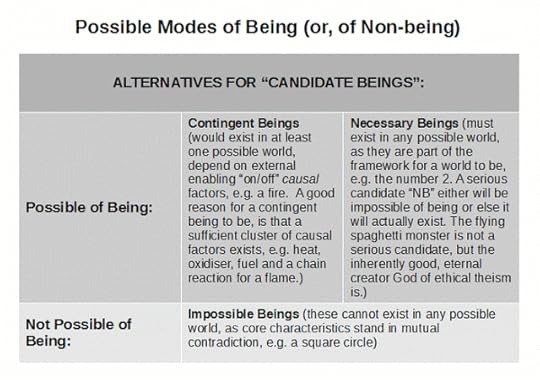
Where also, it is worth the effort to also headline from 375:
KF, 375: >>[W]e can show that key abstract elements of structure and quantity are necessary aspects of the logic of being a distinct possible world.
Consider a distinct possible world, W which is distinct from near neighbours (say W’, W’) by having some aspect of core characteristics A, unique to itself. Were there no A, the world would be indistinguishable from near neighbours and we would recognise that distinct labels have been attached to the same underlying possible world. Such allows us to view W as a structured set:
W = {A|~A}
Now, nothing is in W that is not in A or else ~A, the dichotomy is empty and there is no x in W but not in A or else ~A. This is the quantitative property, nullity; thus zero is present, {} –> 0. Likewise, A is a distinct thing, a unit. Unity is present, so one. Following von Neumann, {0} –> 1, where also A manifests unity. In a different sense, ~A is a complex unity, collecting many other things, pointing to collectives, to systems, to organisation, to function based on organisation etc. For our purposes, ~A is a unit but one different from A, so we need to recognise duality, two-ness, thus two: {0,1} –> 2. Obviously, such succession continues without limit and manifests the naturals, also implying the transfinite ordinals on the premise of order type {0,1,2 . . . } –> w (omega).
Likewise, we may contemplate an inverse such that -x + x –> 0, which is a vector of one dimension. We now have integers. Ratios of integers gives rise to rationals and convergent sums yield the rest of the reals. This gives us continuum. From this, the vector rotation operator i*x repeated twice to give – x allows us to have 2-d vectors in a continuum, a plane. An abstract plane that we may contemplate but which pervades any possible world. Where such a world is sufficiently spatially extended and actualised, we may observe continua, dimensions, vectors, rotations, trajectories etc.
So, we see where any possible world, simply on being distinct, manifests directly 0,1,2 and by extension on the logic of being, N, Z, Q, R, C. The vector phenomenon captured from Z on, allows us to extend the abstract continuum to arbitrarily many dimensions. (Notice the distinction between world manifestations and our extension to n-dimensional entities, n arbitrarily high.In physics we speak of 10^22 degrees of freedom routinely, for statistical thermodynamics, just for a reasonably accessible case.)
Our world manifests three spatial dimensions on the macro scale, and we can observe things like Mobius strips etc.
The underlying point is, that we see intelligible, abstract, necessary, structural and quantitative entities as part of the fabric of any distinct world, part of its framework, part of the logic of its being as a distinct possible world.
In that context, we may identify certain facts of structure and quantity that necessarily obtain.
For instance consider five distinct units and how they may be partitioned into a pair and a triple: ||||| –> || + |||. Obviously, this can be reversed, || + ||| –> |||||. Addition and subtraction have a natural sense of partitioning and combining units. Multiplication and division are extensions as are many onward operations, relations and functions. And so forth.
The point is, that there are abstract, structural and quantitative entities that are intelligible on logic of being which are necessary corollaries of any distinct possible world. These abstracta, we recognise and observe through the effects of the logic of being, we do not invent. They are not merely concepts and constructs we invent and project to a world of things in themselves. That, being in reality just an inner game on the appearances we have and imagine as reflecting the outer world. No, the Kantian ugly gulch fails and we have no good reason to imagine the behaviour of a Mobius strip is some sort of contemplative inner dream. Such dreams we could modify at will, the logic of being is far less yielding than that.
So, we need to frame an understanding of Mathematics that recognises that we may study the logic of structure and quantity, but this is not isolated from the intelligible substance of structure and quantity manifest in the world. Yes, our sense of being and of cause needs to adapt to the logic of being that involves necessary albeit abstract entities. For instance, nullity, the empty set, zero are manifest in a myriad circumstances, indeed in any possible, distinct world. But as {} is indistinguishable from {} there is good reason to see that it is one and the same common entity. Which is a characteristic shown by many abstract entities. >>
So, now, let us further reflect. END
Copyright © 2019 Uncommon Descent . This Feed is for personal non-commercial use only. If you are not reading this material in your news aggregator, the site you are looking at is guilty of copyright infringement UNLESS EXPLICIT PERMISSION OTHERWISE HAS BEEN GIVEN. Please contact legal@uncommondescent.com so we can take legal action immediately.
Plugin by Taragana
March 24, 2019
Gaia needs a reboot and New Scientist is here to explain
 Earth/NASA, DSCVR
Earth/NASA, DSCVRYou know, the eco-Earth religion. Why a reboot? A machine built from scavenged parts from Britain’s Royal Air Force started randomly but ended in equilibrium. Can it boost the Gaia cult?
Ashby believed this “ultrastability” to be a governing principle in nature, explaining, among other things, the adaptation of species to their niche – a process that appears purposeful, but actually arises from random processes. It may seem a stretch to describe the Homeostat’s change over time, from wild motion to stability, as “evolution”. After all, it lacks all the trappings we associate with Darwinian evolution – such as life and reproduction. Bob Holmes, “Gaia rebooted: New version of idea explains how Earth evolved for life” at New Scientist
A stretch? Yes, because it’s the “life” part that’s the trickiest. Most of the article is behind a paywall so you’ll have to bet blind on whether the Homeostat will be the Next Big Thing in Gaia or pay something to find out Bob Holmes’s view first. Here’s saying the idea is good for a month or so. Then onto another craze.
Some of us think that the real threat to Gaia is actually the invented god.
Keeping in mind Murphy’s Fundamental Law (Mother Nature is a bitch who doesn’t need to do what you want or need or expect), it makes much more sense to just invent secular deities as needed, like sci-fi themes.
Follow UD News at Twitter!
See also: Tales of an invented god
Copyright © 2019 Uncommon Descent . This Feed is for personal non-commercial use only. If you are not reading this material in your news aggregator, the site you are looking at is guilty of copyright infringement UNLESS EXPLICIT PERMISSION OTHERWISE HAS BEEN GIVEN. Please contact legal@uncommondescent.com so we can take legal action immediately.
Plugin by Taragana
Atheist public intellectual John Gray separates the atheist wheat from the chaff
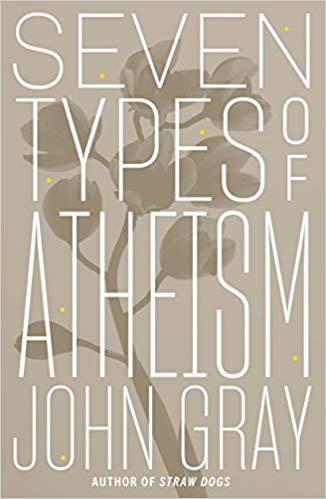
Presumably, he knows the field. From a review of his book, Seven Types of Atheism:
This book should put to rest the canard that atheism is free thinking, and oh so much more broad-minded and gentle than what is on offer from the dull and cramped-spirited God-fearing types. Gray thinks theism ill-conceived, but he does not think it has anything like the distasteful character of most atheism.
Gray reserves special scorn for those he terms“the Enlightenment Evangelists,” a camp that stands for the proposition that human nature freed from religious belief gives us benevolent liberalism. One of his seven types of atheism, Enlightenment Evangelism is represented by the likes of Sam Harris and Richard Dawkins. Typical of this position is the oft-repeated claim that but for the obscurantism of religion, reason would prevail and a sort of John Lennonesque humanistic utopia, knowing neither gods nor borders, would prevail.Graham McAleer, “John Gray Separates the Atheist Wheat from the Chaff” at Law & Liberty
Actually, it’s amazing the number of regimes that made a big to-do about atheism that have ended in mass murder. It would be an interesting project for someone to study whether acknowledging God in a constitution functions as a sort of insurance policy against really high death tolls. It’s an arguable point.
Follow UD News at Twitter!
See also: (but not to be taken altogether seriously, in case you wondered): Neuroskeptic: Atheists are NOT genetically damaged
Of course, the claim is nonsense but then those of us who have listened to rubbish about the God gene and such can’t help hiding a giggle. Hey, given that it’s Hate Your Local Atheist Week anyway, how about “Atheists have mutant genes, don’t live as long “
and
There’s a gene for that… or is there?
Copyright © 2019 Uncommon Descent . This Feed is for personal non-commercial use only. If you are not reading this material in your news aggregator, the site you are looking at is guilty of copyright infringement UNLESS EXPLICIT PERMISSION OTHERWISE HAS BEEN GIVEN. Please contact legal@uncommondescent.com so we can take legal action immediately.
Plugin by Taragana
Does the idea of a blind, undirected cosmos govern our ideas of sexuality?

Is there a natural way to live?
Are we happier if we follow it? Nancy Pearcey, author of Love Thy Body: Answering Hard Questions about Life and Sexuality, defends that view in this excerpt :
Every ethic stems ultimately from a view of nature—because our bodies are part of nature. The liberal secular ethic derives from the theory that nature is a product of blind, undirected forces. Of course, it was Darwin’s theory of evolution that cemented that idea in the modern mind. The two key elements of his theory–random mutation and the blind, automatic process of natural selection–were specifically intended to get rid of the concept of purpose and design in nature. As historian Jacques Barzun put it, “The denial of purpose is Darwin’s distinctive contention.”
Here’s how a recent New Yorker article put it, “the loyalty oath of modernity”–isn’t that a grand phrase—the loyalty oath you must take if you want to be considered a modern person—is that “nature is without conscious design … the emergence of Homo sapiens was without meaning or telos” (the Greek word for goal or purpose).
The implication is that the human body has no intrinsic purpose that we are morally obligated to respect—and the mind is free to use it any way it wants.
That’s exactly how homosexuality is defended by the outspoken lesbian and public intellectual Camille Paglia.
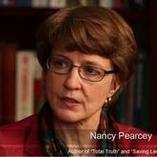 Nancy Pearcey
Nancy PearceyCamille Paglia rejects the idea that sexuality is a social construction. No, she writes, nature made us male and female—humans are a sexually reproducing species. But then she asks, and these are her words: Why not “defy” nature? After all, “Fate, not God, has given us this flesh. We have absolute claim to our bodies and may do with them as we see fit.”
The logic is that if our bodies are products of mindless, purposeless forces, then they convey no moral message, they give no clue to our identity, “We may do with them as we see fit.”
By contrast a Christian view of nature is teleological, which comes from that same Greek word telos, meaning goal or purpose. It is evident to observation that living things are structured for a purpose: Eyes are for seeing, ears are for hearing, wings are for flying, fins are for swimming. The development of the entire organism is directed by an in-built genetic plan or blueprint. The reality is that nature exhibits a design, a plan, an order, a purpose—and when we live in harmony with that purpose, we are healthier and happier.
In Love Thy Body I tell the story of a woman named Jean who lived as a lesbian for several years, but is now married with 2 children.
Jean said: I finally came to trust that God made me female for a reason, and I wanted to “honor my body by living in accord with the Creator’s design.”
In fact, in Love Thy Body I tell lots of personal stories, and one of my favorites is the story of Sean. As a young man, he identified as gay and was exclusively attracted to other men. Today he is married to a woman and has three children. What changed? What’s interesting is that Sean grew up in a “gay affirming” family and attended a “gay affirming” church, so his change was not driven by any sense of guilt or shame. Instead, Sean says, I stopped defining my identity by my sexual feelings “and started regarding my physical body as who I was.” His goal was not to try to change his feelings, which rarely works. “Rather, it was to acknowledge what I already had (a male body) as a good gift from God.” And eventually “my feelings started to follow suit.” Instead of defying nature, to use Paglia’s words, he accepted his embodied existence as fundamentally good. That’s really the question at the core of this debate: Do we live in a cosmos operating by blind, material causes?
Or a cosmos created by a loving Creator which is therefore intrinsically good?
See also: Nancy Pearcey At More Than Cake, On How Darwin Really Triumphed
Copyright © 2019 Uncommon Descent . This Feed is for personal non-commercial use only. If you are not reading this material in your news aggregator, the site you are looking at is guilty of copyright infringement UNLESS EXPLICIT PERMISSION OTHERWISE HAS BEEN GIVEN. Please contact legal@uncommondescent.com so we can take legal action immediately.
Plugin by Taragana
Darwinism’s influence on philosopher of science Thomas Kuhn
Further to the question raised by John Horgan at Scientific American, as to whether philosopher of science Thomas Kuhn was “evil,” a friend writes to say,
I haven’t read Errol Morris’s book about Kuhn, but I read Kuhn’s Structure of Scientific Revolutions when it first came out, and I’ve read it several times since then. I also heard Kuhn speak to academic audiences years ago.
Whatever else one may say about Kuhn’s most famous book, I think one thing is clear: He described with amazing insight how the scientific establishment works to suppress a radically new idea. Viewed through the spectacles of someone involved in the controversy over intelligent design, Kuhn’s book was uncannily prophetic.
Kuhn was accused of relativism, and it’s true that he attributed the victories of new “paradigms” to non-empirical factors. Yet there was one paradigm that Kuhn assumed was not a paradigm, but a fact of nature: Darwinism. His whole approach to scientific revolutions was Darwinian. New paradigms emerge as accidental mutations, not because of new evidence. Old and new paradigms then compete for survival, with the winner coming out on top for reasons other than the evidence.
I’m reminded of a conversation I once had with a communist. We were talking about scientific revolutions, and I argued that all scientific theories have subjective elements. He begged to differ, and said he knew of one science that was totally objective. “What that?” I said, intrigued. “The Marxist view of history,” he answered. It took me a while to pick my chin up off the floor.
Wow. That’s bigger than an Ashtray.
Follow UD News at Twitter!
See also: Was philosopher of science Thomas Kuhn “evil” Postmodernism is to science what rabies is to dogs. That is, it will lead to post-science as surely as rabies leads to post-dogs. But by all means, let them fight in the meantime.
Copyright © 2019 Uncommon Descent . This Feed is for personal non-commercial use only. If you are not reading this material in your news aggregator, the site you are looking at is guilty of copyright infringement UNLESS EXPLICIT PERMISSION OTHERWISE HAS BEEN GIVEN. Please contact legal@uncommondescent.com so we can take legal action immediately.
Plugin by Taragana
March 23, 2019
Philosopher of science Steve Meyer will be on Ben Shapiro’s show Sunday
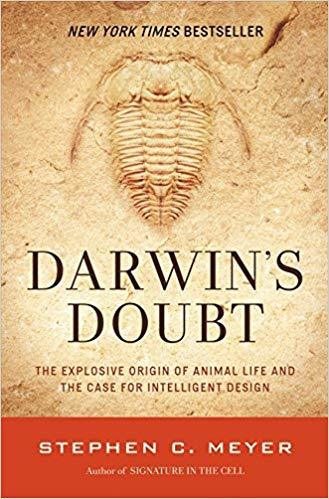
Steve Meyer is the author of Signature in the Cell and Darwin’s Doubt.
Not everyone wants to hear what he has to say:
It was announced on Twitter this morning, and as you can imagine, the Twitterati are not pleased. They are bombarding the show with replies about “bunk science and the 6,000 year old universe,” “Why not have a hour long discussing with a Flat Earther? Just as much evidence to support that claim as there is for ID,” and so on.David Klinghoffer, “Stephen Meyer on the Ben Shapiro Show This Sunday: God, Intelligent Design, and More” at Evolution News and Science Today:
You have to subscribe to watch the show tomorrow but it will be in the archives later even if Twitter melts down in the meantime.
This week on The @BenShapiro Show: Sunday Special it’s Dr. Stephen Meyer discussing intelligent design, God, science and the universe!!
Tune in on 3/24 ==> https://t.co/qWSK2rHgDC pic.twitter.com/Dvn7Y5qpZs— The Daily Wire (@realDailyWire) March 22, 2019
Copyright © 2019 Uncommon Descent . This Feed is for personal non-commercial use only. If you are not reading this material in your news aggregator, the site you are looking at is guilty of copyright infringement UNLESS EXPLICIT PERMISSION OTHERWISE HAS BEEN GIVEN. Please contact legal@uncommondescent.com so we can take legal action immediately.
Plugin by Taragana
Was philosopher of science Thomas Kuhn “evil”

The guy who coined the term “paradigm shift” is evil? So implies The Ashtray: (Or the Man Who Denied Reality), written by filmmaker Errol Morris, who was once Kuhn’s grad student (and Kuhn threw an ashtray at him and tossed him from the program).
The rap from Morris is, Kuhn empowered right-wing dictators but a reviewer sees the reality as a bit more complex:
Morris proposes that postmodernism is an attractive ideology for right-wing authoritarians. To support this claim, he notes the scorn for truth evinced by Hitler and the current U.S. President, for whom power trumps truth. Morris suggests that “belief in a real world, in truth and in reference, does seem to speak to the left; the denial of the real world, of truth and reference, to the right.”
That’s simply wrong. Postmodernism has often been coupled with progressive, anti-authoritarian critiques of imperialism, capitalism, racism and sexism. Postmodernists like Derrida, Foucault, Butler and Paul Feyerabend (my favorite philosopher) have challenged the political, moral and scientific paradigms that enable people in power to maintain the status quo .John Horgan, “Was Thomas Kuhn Evil?” at Scientific American
Postmodernism is to science what rabies is to dogs. That is, it will lead to post-science as surely as rabies leads to post-dogs. But no reason not to let them fight in the meantime.
Follow UD News at Twitter!
See also: What becomes of science when the evidence does not matter?
and
Is there life Post-Truth?
Copyright © 2019 Uncommon Descent . This Feed is for personal non-commercial use only. If you are not reading this material in your news aggregator, the site you are looking at is guilty of copyright infringement UNLESS EXPLICIT PERMISSION OTHERWISE HAS BEEN GIVEN. Please contact legal@uncommondescent.com so we can take legal action immediately.
Plugin by Taragana
Michael J. Behe's Blog
- Michael J. Behe's profile
- 219 followers



